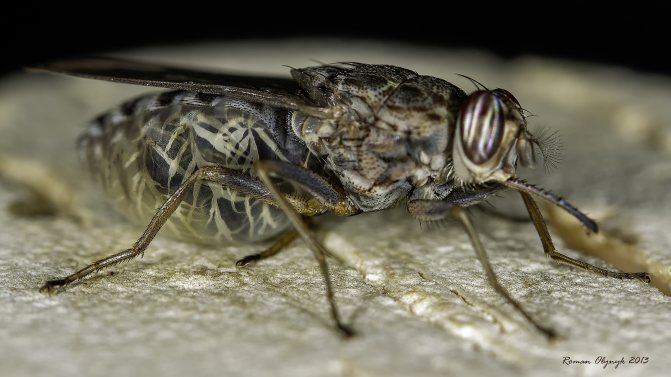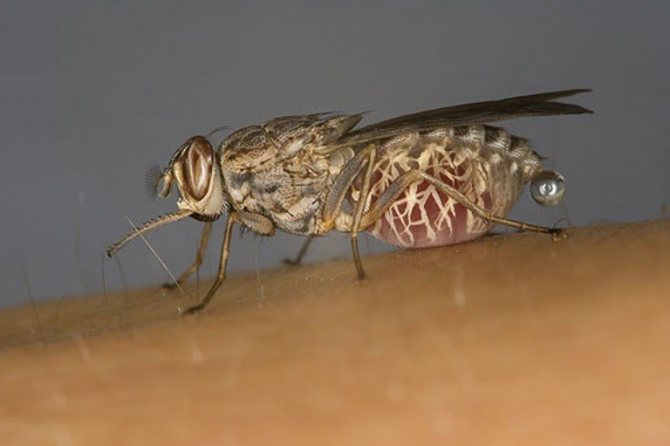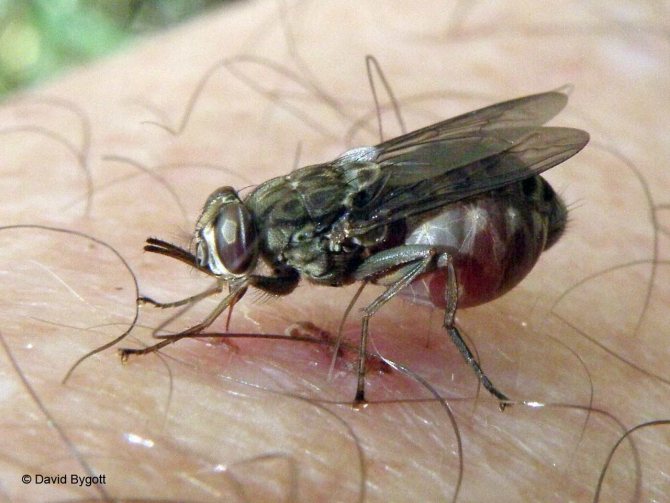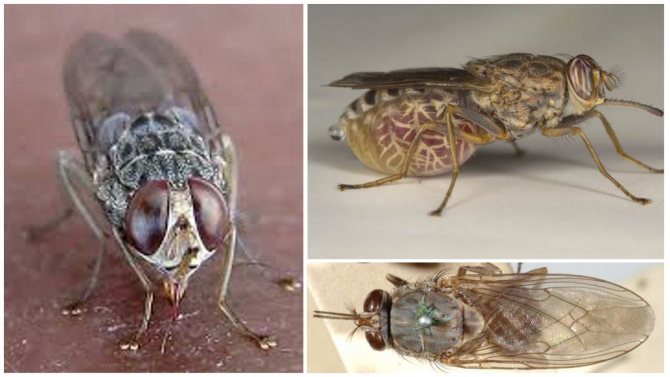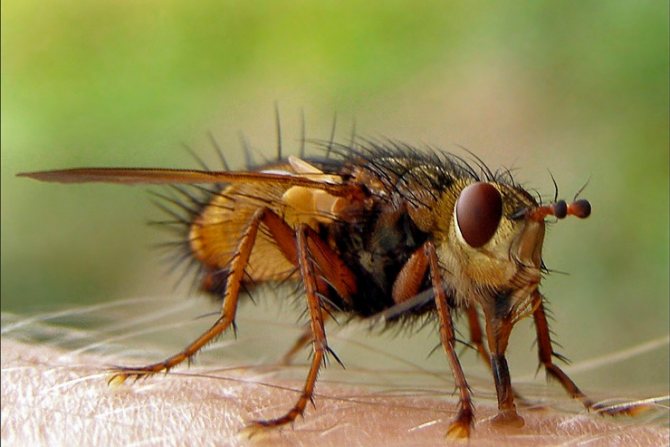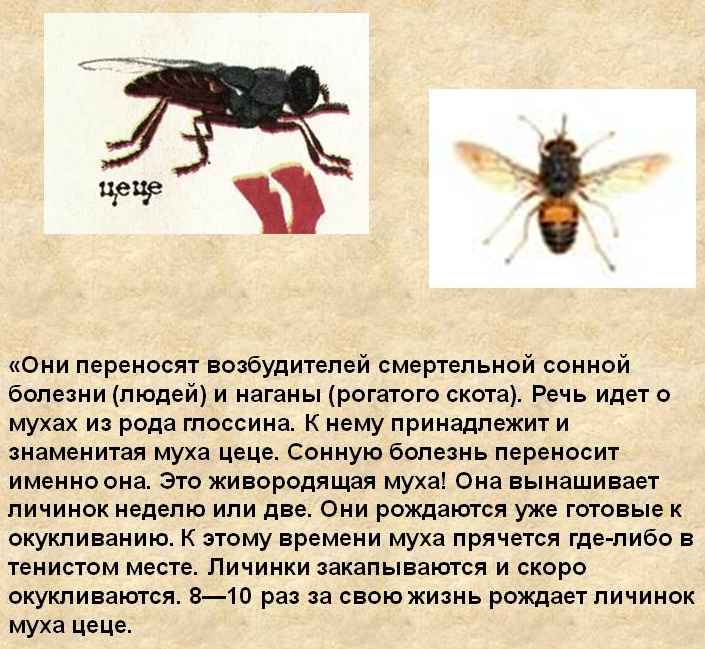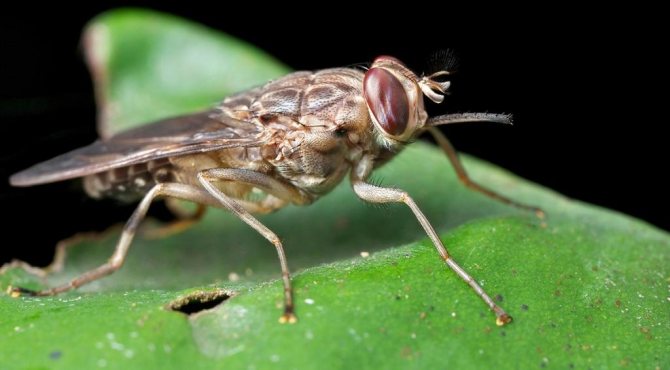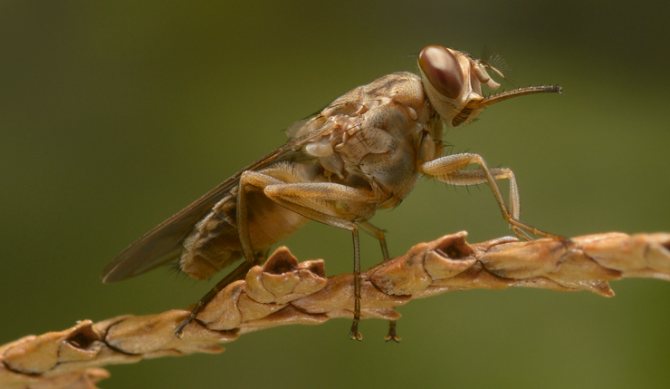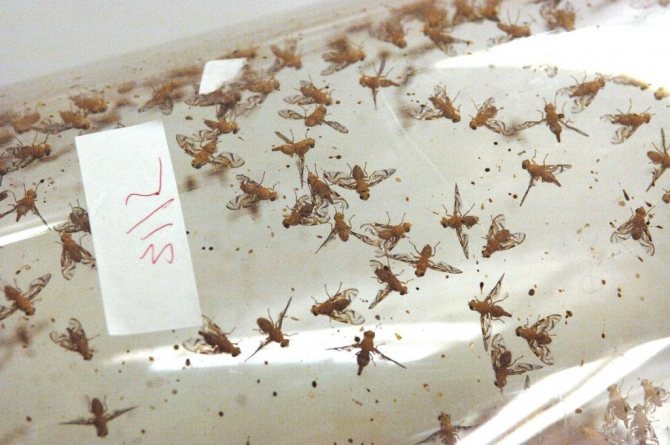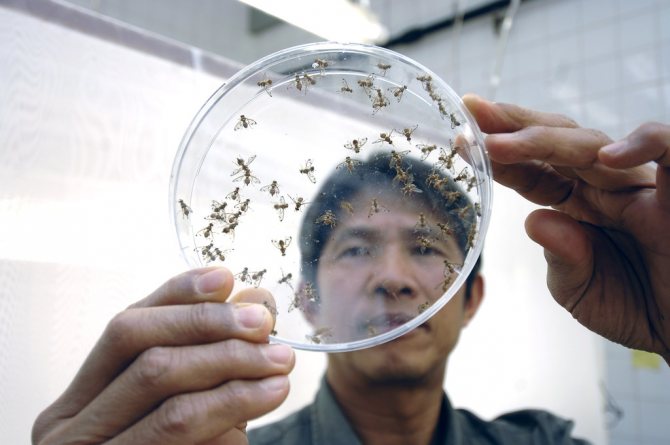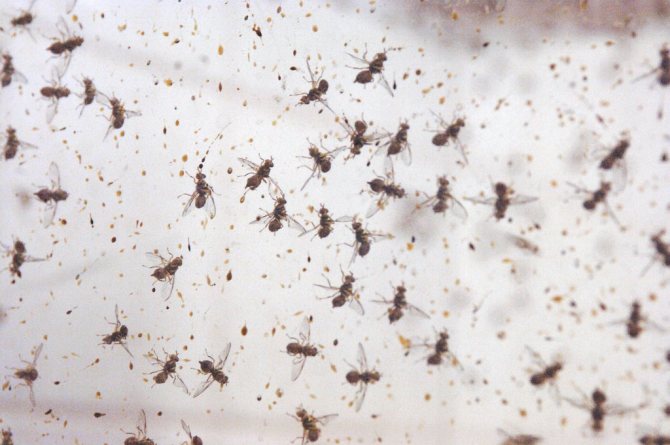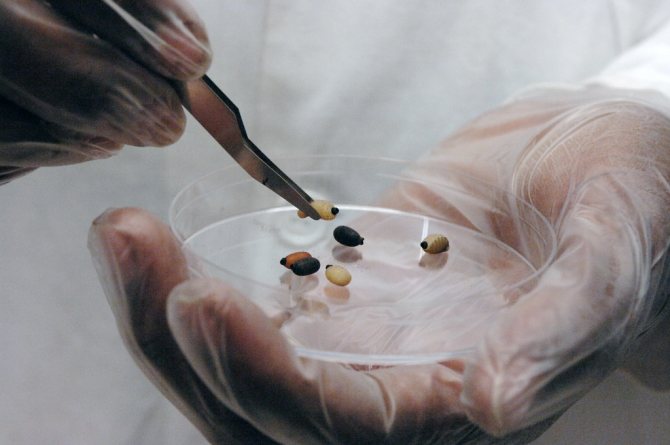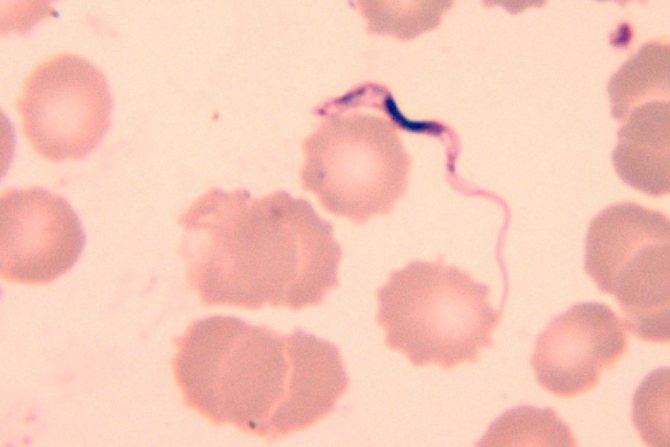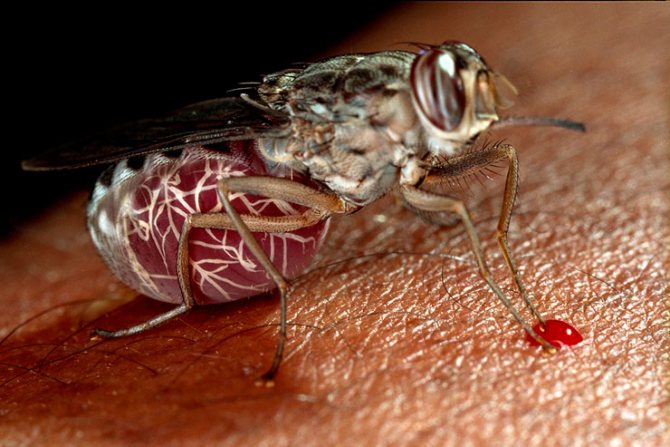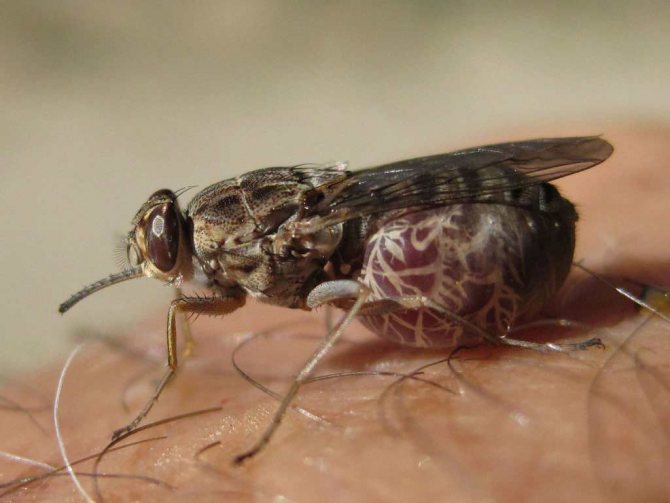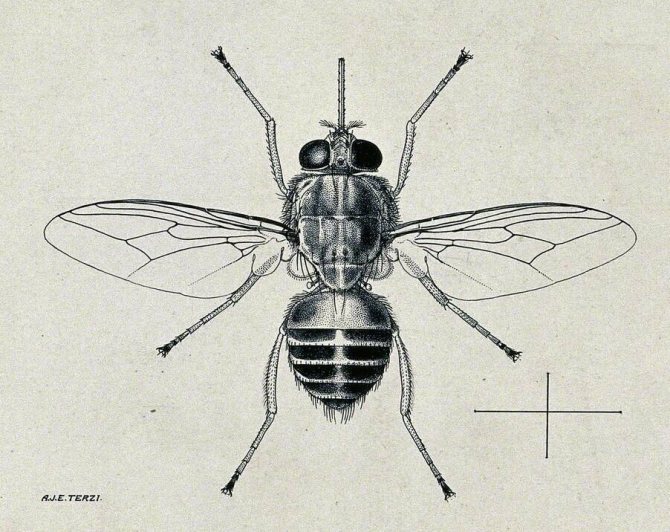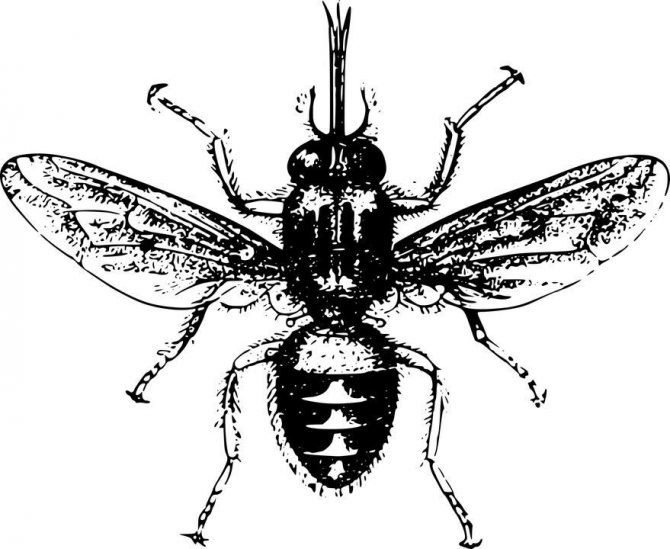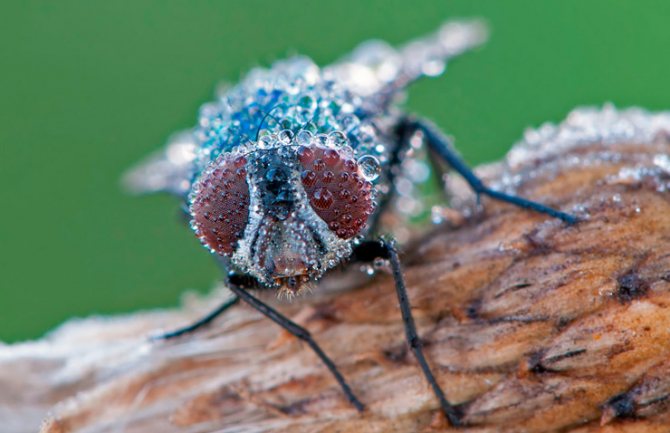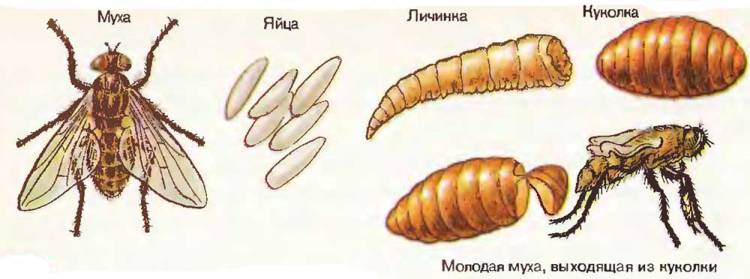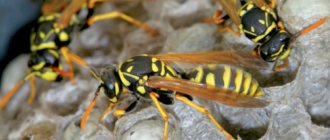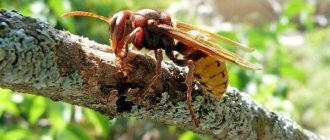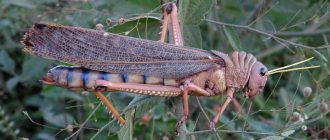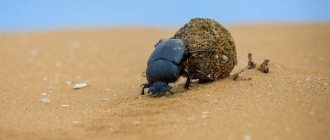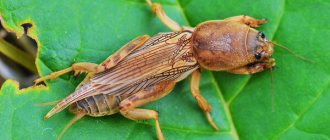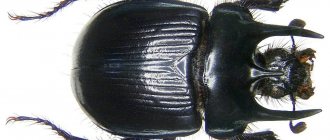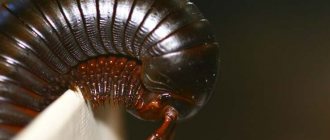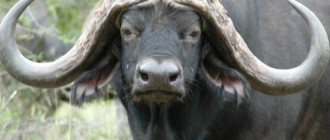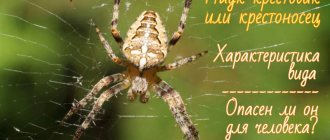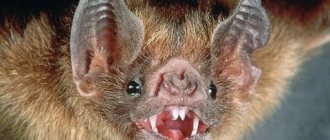
Tsetse fly belongs to the flies of the Glossinidse family, of which there are about twenty-three varieties. Most of the insects of this order pose a certain danger to humans, in particular tsetse fly bite is considered a carrier of such dangerous diseases as "sleepy" or "revolver" that affects cattle.
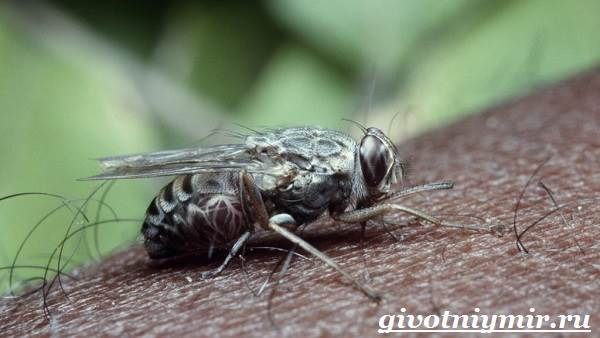

About the tsetse fly it is known for certain that her direct relatives lived on our planet more than thirty million years ago. One way or another, virtually any person, starting with elementary schoolchildren of secondary schools, heard the name of this insect at least with the edge of his ear.
Appearance
The fly is neither impressive in size nor bright in color. This is a nondescript gray insect. The size of the tsetse fly varies from 9 to 14 mm, depending on which species of this dangerous genus a particular insect belongs to. The tsetse has a reddish-gray breast with 4 longitudinal dark brown stripes, the abdomen is yellowish above and gray below. On a note! If the fly sits calmly, then the general impression of the color is gray. The wings folded on top of each other do not allow you to see the color of the small abdomen, and the chest is clearly visible. All types of tsetse flies have 4 characteristics that make it possible to distinguish them from the usual dipteran relatives living in Europe: The piercing-type proboscis is directed not downward, but forward.
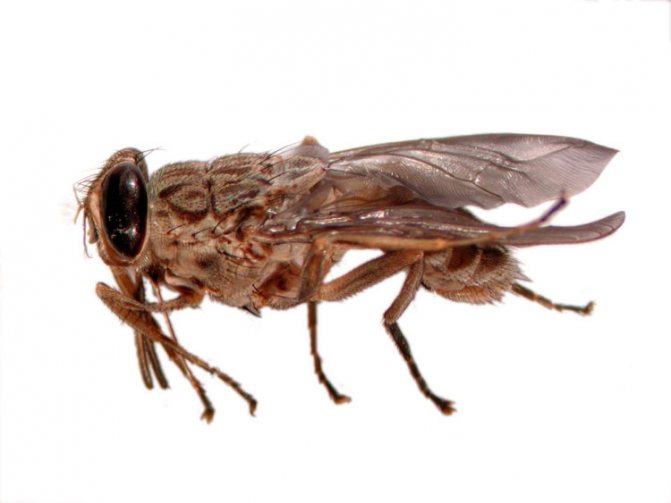

In a calm state, the wings are fully folded and lie on top of each other. The other two signs are easier to see on a killed insect. The wing has a characteristic vein pattern: in the middle of the wing, the intersection of the veins forms the silhouette of a butcher's knife. The antennae-antenna of the tsetse are "fluffy". The awn growing on the main antenna branches off at the end. This characteristic appearance makes it easy to distinguish the killer fly from all other insects of the African savannah.
Habitat
The tsetse flies are most widespread in equatorial and subequatorial Africa, and their habitat is quite extensive. These are numerous states of Central, Eastern and Southern Africa, for example, Zambia, Angola, Congo, Rwanda, Tanzania, Uganda, etc. For the normal existence of tsetse flies, a hot and humid climate is important, therefore, in arid North Africa, for example, Tunisia, Algeria or Sudan these insects do not survive.
However, even in favorable biotopes, tsetse flies choose the best living conditions for themselves - not only damp tropical forests, but also fertile savannah lands stretching along the river banks.
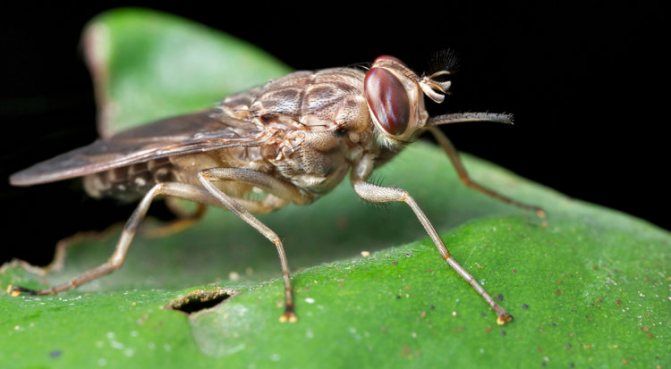

The selectivity of insects forces farmers and pastoralists to leave the best places, and this is precisely the undoubted benefit of the tsetse fly. Thanks to this monopoly, Africa has preserved a unique ecosystem of untouched equatorial forests, home to many endemic species of wild animals. A kind of protection protects the land from overgrazing and, as a result, from soil erosion.
However, not all tsetse live in similar biotopes, depending on the attachment to a particular area, insects could be classified into 3 groups of species.
Tsetse fly species
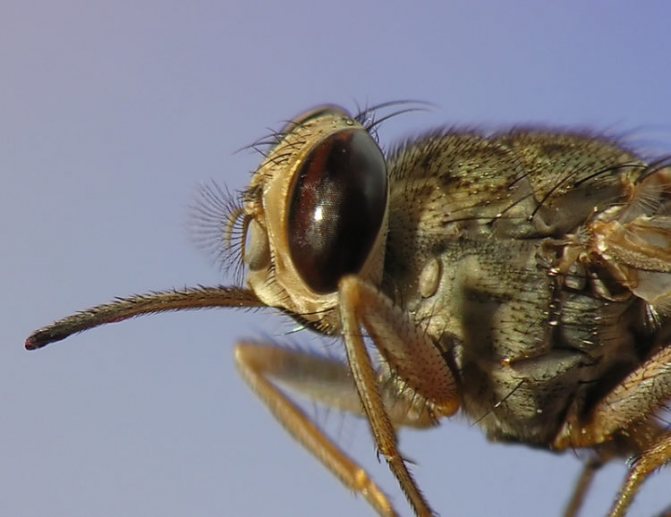

It is difficult to imagine what effort and probably suffering it took entomologists to study and combine dangerous insects into separate groups:
- representatives of the morsitans group live mainly in savanna forests and savannas, easily adapting to a relatively dry climate.It was these flies that contributed to the growth of the wooded savannah area, which caused the Sierra Leonean herders to stop raising horses;
- species of the fusca group are typical inhabitants of tropical rainforests, their bites mainly go to wild mammals, less often to humans and livestock;
- tsetse flies from the palpalis group are the most moisture-loving, but they are attracted not by jungle swamps, but by open areas along river banks, where fishermen and swimmers are most often victims of insects.
It is in such natural conditions that the most dangerous insects of the planet live and breed safely, because they do not experience a deficit in the food source.
Lifestyle
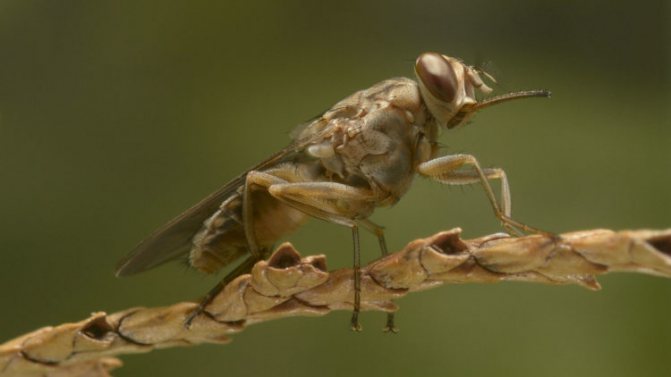

The choice of habitats and food items depends on belonging to one of three groups.
- Palpalis - Prefers thickets and shrubs growing near water. They bite reptiles, attack humans.
- Fusca - the species hides in the depths of the rainforest, selects areas with high humidity and moderate temperatures. Does not eat in public.
- Morsitans - live in the savannas in southern Africa, feed on wild ungulates and domestic cattle. Dangerous to humans.
Unlike many insects, the tsetse spends most of its life cycle as an adult. Adults live 6-7 months. In the dry season, they gather at the remains of reservoirs, hide under leaves, look for places where dampness remains. At such times they hardly fly. This is not necessary, because the food itself comes to the watering place. Females and males drink blood, feed often. Why is a tsetse fly bite dangerous for an animal? She is the carrier of one of the types of trypanosomes that cause revolver disease. Infected animals become weaker and die. The disease affects predators, artiodactyls, horses. Among the many species, zebras are safe. They are saved by the black and white coloring, which is not perceived by the tsetse.
Food
The common food source for tsetse flies is the blood of small wild mammals.
Reproduction
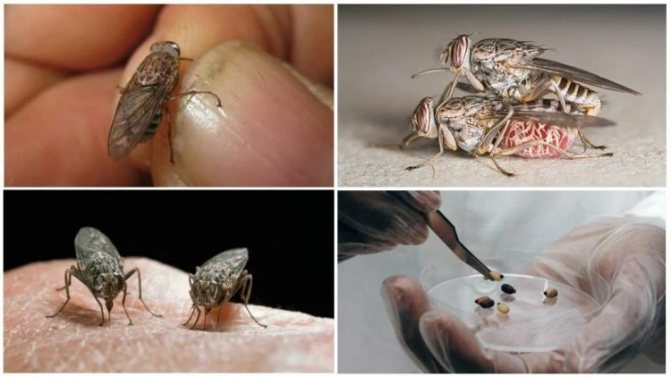

All tsetse species are viviparous, the larvae are born ready to pupate. The female bears the larvae for a week or two, at a time lays a fully developed larva on the ground, which buries itself and immediately pupates. By this time, the fly is hiding in a shady place. During its life, the fly gives birth to larvae 8-10 times.
Life cycle
The tsetse has an unusual breeding method associated with an abundant food supply. Technically, it goes through all the standard phases of insect development:
- egg;
- 3 larval stages;
- chrysalis;
- imago.
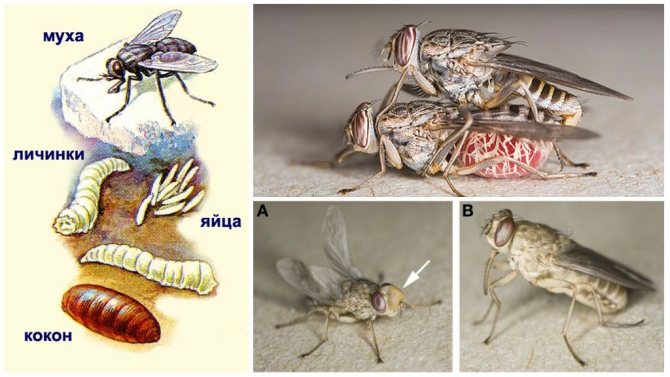

Life cycle of a tsetse fly
But you can only see the last one. Until the last stage of the larva, the fly develops inside the female. During intrauterine development, the larva feeds on an analogue of milk, which is secreted by a modified gland in the uterus. At the third stage, the larva leaves the female and immediately buries itself in moist ground. It pupates in the soil.
Pupal development lasts 20-30 days. The imago emerging from the cocoon immediately flies in search of a sexual partner and food.
Interesting!
Both sexes drink blood from the tsetse.
Flies live for several years. The female lays only one larva at a time. For a year, she can lay off only 4-6 units of offspring. But over a lifetime, the number of larvae reaches 31. A female needs high-calorie protein food to live and feed full-fledged offspring. The abdomen of the tsetse is arranged in such a way that at one time the female can drink as much blood as she weighs.
Why is tsetse dangerous for humans?
This insect is dangerous not only for humans, but also for any other mammal that does not have immunity to diseases carried by these bloodsuckers. Tsetse - do not belong to poisonous flies, but very often they are carriers of the causative agent of sleeping sickness trypanosome. They can also carry any other diseases that are transmitted through a fly bite. On a note! Trypanosome is the simplest organism that causes a parasitic disease in livestock and humans.Of domestic animals, only Mosai ponies living in the Logone River valley are resistant to sleeping sickness.
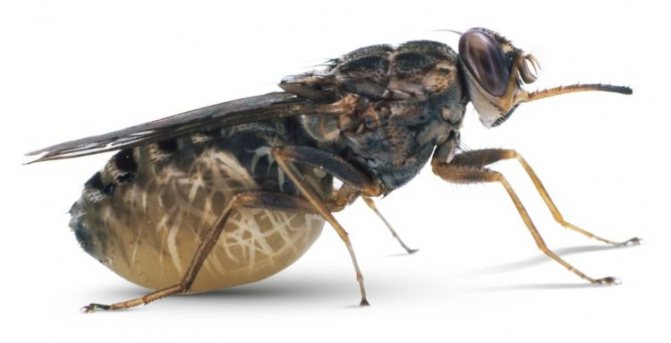

There are several types of Trypanos. Two of them are dangerous to humans. The hosts of the infection are African antelopes, which the parasite does not cause any harm. The bloodsucker sucks the parasite along with the blood of the antelope. For the tsetse, trypanosomes are also harmless. These flies are carriers of the disease, but they themselves do not die. The simplest parasite enters the human blood through the bite of a tsetse fly, which has previously drunk the blood of an infected animal. Unlike wild African animals that have adapted to trypanosomiasis, these parasites cause a dangerous disease in humans, often leading to death.
Important! Trypanosomiasis can also be transmitted by other blood-sucking insects living in the same area as the tsetse.
On the African continent, two types of trypanosomes are dangerous to humans. One of these causes Gambian trypanosomiasis, which is common in West Africa and accounts for 95% of all sleeping sickness cases. The second is "responsible" for the emergence of the Rhodesian form endemic to Eastern and Southern Africa and occurring in only 5% of cases of the total number of trypanosomiasis diseases.
How to deal with this parasite?
For many years now, mankind has been trying to develop effective means of combating this dangerous insect. For the first time, the technology for reducing the tsetse fly population was developed in the 30s of the last century. Its essence consisted in the extermination of all animals on a certain plot of land, the blood of which it feeds on. This bold and radical method proved to be successful - on the island of Principe in Africa, thanks to it, all flies disappeared. After more


For 10 years, the insect reappeared there and began to multiply, but this time the flies were no longer carriers of the parasites of trypanosomes.
Later, in the 40s, another method was tried, which consisted in the destruction of vegetation. The tsetse fly spends most of its life in trees. Therefore, the absence of trees leads to a decrease in the insect population. Thus, it was decided to create impossible conditions for flies in some areas. However, the use of this method turned out to be dangerous for the environment, and it was resorted to only in cases where tsetse flies were infected with an area in which a large number of people live.
Also in the first half of the twentieth century, pesticides were used to control the tsetse fly, which were sprayed over the infected area using airplanes. But this method, like all other chemical control measures, turned out to be ineffective. The poison enters the food chains of ecosystems and poses a huge danger to all living organisms.
Traps
Oddly enough, such a simple and effective method as traps began to be used only in the second half of the twentieth century.
The standard trap is a cloth soaked in an insecticide solution that attracts flies due to its blue color.
For the same purposes, you can successfully use buffalo skins or any other dark-colored material.
Bait
A careful study of the behavior of flies has allowed scientists to figure out what attracts insects to


animal smell of a mixture of substances (acetone and carbon dioxide), which is released on exhalation. Due to the wind, the tsetse fly is able to smell this smell at very long distances. As a result of the research, synthetic variations of the substance exhaled by animals have been developed to lure an insect into a trap with pesticides. But, as it turned out later, the same effect can be achieved by placing half a pumpkin filled with cattle urine next to the trap.
The safest way to deal with the pine cocoon moth is to attract biological enemies of the insect.Who feeds on this pest, read this article.
The gadfly bite is very dangerous for both animals and humans, since the larvae of this insect feed on flesh.
Sterilization
The method of sterilizing male tsetse flies has proven to be one of the most effective. Sterilization is carried out using radioactive radiation. After that, males incapable of fertilization are released into the wild in places where the greatest concentration of healthy individuals is observed. Mating of a healthy female with an irradiated male leads to the impossibility of fertilization of eggs.
The frequent introduction of infertile flies into infested regions significantly reduces insect reproduction. As a result, it is possible to reduce the number of deadly flies many times over, which can lead to the complete extinction of the range. The sterilization technology is especially successful in combination with insecticides.
Personal prevention
For these purposes, simple and time-tested protection methods are used: a door to
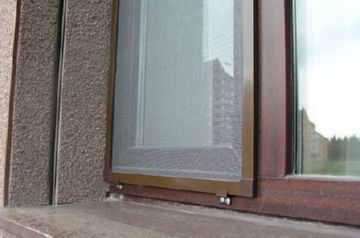

the room must be closed, and windows and other open parts must be checked (it is best to use mosquito nets); use overalls and use repellents.
According to scientists, a decrease in the tsetse fly population does absolutely no harm to the ecosystem. Today, as a result of the fight against this insect in Africa, many lifeless, desert regions have been identified. Thus, the tsetse fly provokes hunger, an increase in mortality rates and economic decline in African countries.
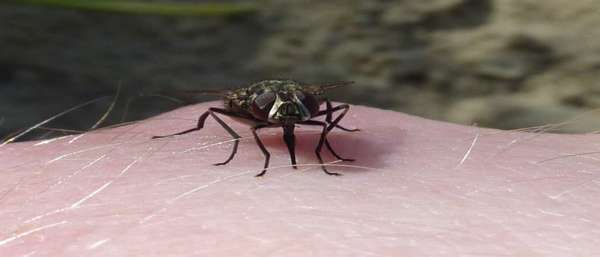

Diptera are activated in autumn - during this period they begin to bite animals and people. Females are especially aggressive, because they need improved nutrition in order to produce offspring. The danger of a fly bite is that when the skin is punctured, the insect can infect a person with an infection. Among these insects, which are ubiquitous, there are extremely dangerous individuals. For example, the tsetse fly. It is considered the causative agent of trypanosomiasis. Fortunately, such species only live in Africa, but travel enthusiasts should remember that a fly bite of this kind can be fatal.
Why is a tsetse fly bite dangerous?
It is important to understand that the insect bite itself is not dangerous, because these flies are not poisonous. However, they feed on wild animals, many of them are infected with trypanosomiasis (sleeping sickness), which is caused by the unicellular parasites of trypanosome. Their danger lies in the slow and methodical destruction of vital body systems.
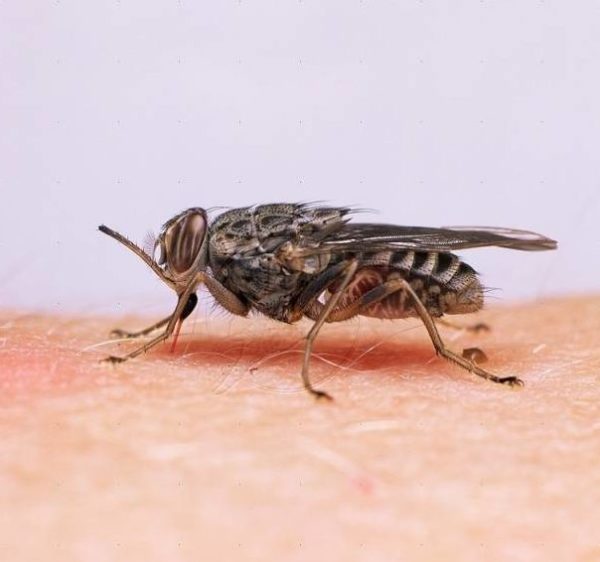

Thirst for blood causes the tsetse fly to throw itself at any object that radiates heat, be it a wild animal, livestock or a person. Trypanosomes do not harm the fly itself, and once in the victim's wound with the saliva of an insect, they begin to actively multiply in the body of a new host, and here it is important to recognize the symptoms of trypanosomiasis in time and, if possible, differentiate from other numerous African diseases.
Do dung beetles live in an apartment?
Since dung beetles are predators, they usually have nothing to eat in the house. Therefore, they are extremely rare to be found in a person's dwelling, except that a fly flew into the house purely by accident.
Livestock pens are their habitat only during the mating season, when it is necessary to conceive and breed. At this time, male dung flies flock to fresh dung and wait for females. When they appear, sometimes several gentlemen rush to one lady at once, striving to preserve their own gene pool.
Scientists-entomologists have found that the most preferred for flies is pig manure, as well as the manure of young calves that feed on milk. It stays fresh for the longest time and maintains the necessary temperature for the life and development of larvae, while horse manure dries out rather quickly.
Symptoms and treatment
The worst thing is that a person may not be aware of a tsetse fly bite for up to three weeks! Therefore, for preventive purposes, people from the risk group regularly take blood tests.
1-3 weeks after the bite, the first symptoms appear: chills, head and joint pain, which are often mistaken for manifestations of the flu. Neurological symptoms may appear after a few months. These are drowsiness, confusion, numbness of the limbs, disorder of the vestibular apparatus. By this time, the immune system is seriously impaired and if treatment is not prescribed, the person dies.
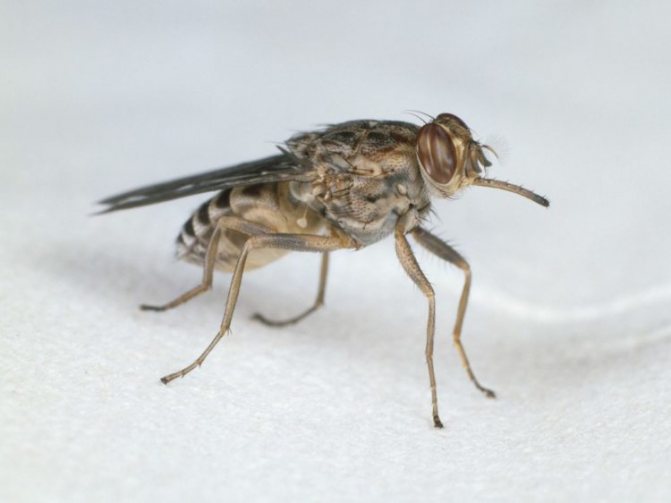

Trypanosomes are found with a blood test or lumbar puncture. For the treatment of sleeping sickness, special antiprotozoal and anthelmintic drugs have been developed, for example, "Suramin", "Pentamidine", "Eflornithine", "Nifurtimox".
Despite preventive measures and the use of various methods of tsetse fly control, millions of people from 36 African countries are at risk of infection every year.
Symptoms


Consequences of a tsetse fly bite
At the first stage of the development of the disease, joint pain, fever, itching, and headache occur. These symptoms appear 1-3 weeks after being bitten by an infected insect and last for several weeks or months.
If no treatment measures are taken, the second stage begins: coordination of movements is disturbed, consciousness is confused, the sleep-wake cycle is disturbed, and numbness of the extremities occurs. If medical assistance was not provided, the person falls into a coma, which turns into death.
On a note!
Because of sleep disturbance, this disease is called "sleeping sickness".
Control methods
The first attempts to get rid of the tsetse fly were made at the beginning of the last century, when hundreds of thousands of animals were exterminated: elephants, lions and ungulates. However, this did not affect the state of the tsetse population; the flies survived by feeding on the blood of mouse-like rodents, birds and amphibians, which are also carriers of trypanosomiasis.
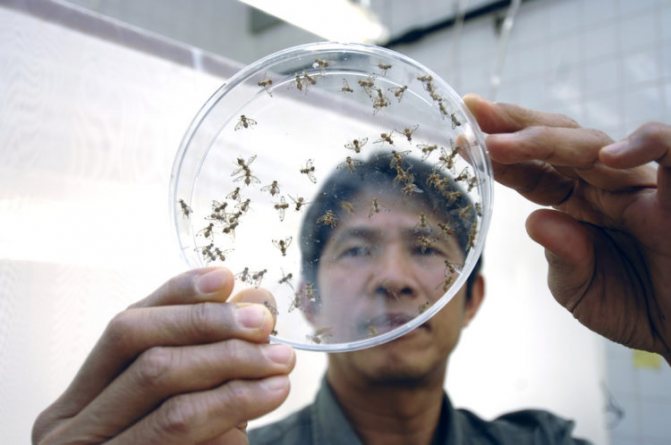

Deforestation of shrub thickets also did not bring success, and in the 40s, the use of the insecticide DDT against insects became the main method of control. But this turned out to be a temporary measure: like in most insect pests, the tsetse organism quickly acquires immunity to pesticides.
Not all tsetse flies are carriers of trypanosomiasis, but visitors to exotic Africa who have been bitten by a characteristic insect are advised to seek immediate medical attention.
Interesting Facts
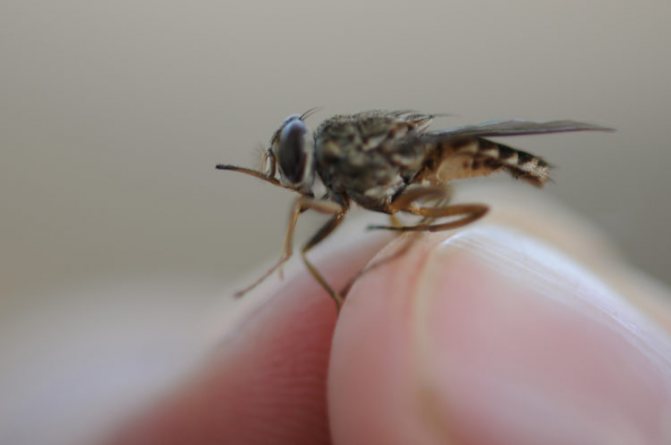

Despite its terrible reputation, the tsetse fly is of particular interest from the point of view of entomology and every insect lover can tell a lot of interesting things about it, for example:
- many wild animals have developed immunity to tsetse bites for centuries, which is not the case with livestock and horses;
- Zebras are the only inhabitants of the savannah, reliably protected from fly bites by their striped color. The flickering of black and white stripes, for some reason, scares away insects;
- tsetse willingly rush to cars with a hot engine, considering them edible objects;
- swatting houseflies and tsetse are two big differences. A stunned or wounded tropical vampire will still find the strength to reach the victim;
- Zanzibar scientists made an original attempt to prevent the spread of dangerous insects in the spirit of modernity. Millions of flies were reared in the laboratory, and males, separated from females, were sterilized by irradiation. Released insects mated but did not produce offspring;
- sad, but optimistic statistics: in 1990, after a tsetse bite, 34 thousand people died, and in 2010, 9 thousand deaths were recorded.
First aid
The most painful are multiple injuries: if a fly has bitten the legs, arms, abdomen and other parts of the body, inflammation develops. From the bite, soft tissues swell, and general well-being may worsen.The wounds of the bitten are treated with an antiseptic - brilliant green, alcohol, iodine.
How to smear baby bites? In this case, non-alcoholic agents will help - chlorhexidine, hydrogen peroxide. Also, with a bite, soothing and cooling ointments help out, which makes the manifestations of local reactions less. To prevent fly bites in children from provoking allergies, they give Zodak in drops or Diazolin for children.

